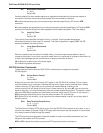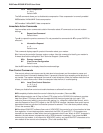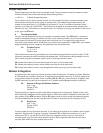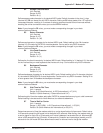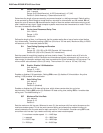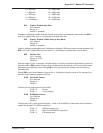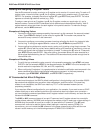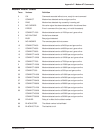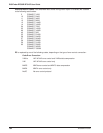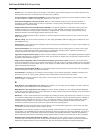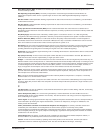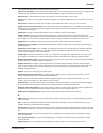
RASFinder RF300E/RF310E User Guide
RF300E/RF310E
180
Reading and Assigning S-Register Values
Use the S command to assign a value to an S-register and to read an it’s current value. To read an S-
register value, in terminal mode, type S, the S-register number, and a question mark (?), and press
ENTER. For example, to display the value of register S7, type ATS7? and press ENTER. The value
appears as a three-digit decimal number (e.g., 045).
To assign a new value to an S-register, type S, the S-register number, an equals sign (=), and a
decimal number. Convert all ASCII characters to their decimal equivalents before entering. Valid S-
register decimal values are shown for each register in the previous section. To make the change
permanent, use the &W0 command.
Examples of Assigning Values
1. You want to have longer pauses caused by the comma in a dial command: five seconds instead
of two. Type ATS8=5 to assign 5 as the value for register S8. The modem now pauses five
seconds for every comma in a dial command.
2. You want to configure your modem to answer incoming calls after the fourth ring instead of after
the first ring. To configure register S0 with a value of 4, type ATS0=4 and press ENTER.
3. You are calling long distance to another country code, and it is taking a long time to connect. The
register S7 (time to wait for carrier) factory default setting of 50 seconds is insufficient; a time-out
occurs and cancels the call before a connection is made. To change the S7 value to 75 seconds,
type ATS7=75 and press ENTER . Now, after dialing, the modem allows 25 more seconds for a
carrier signal before aborting the call. The additional 25 seconds should provide enough time for
international calls.
Examples of Reading Values
1. To verify that you entered the value correctly in the preceding examples, type ATS8? and press
ENTER in the first example, ATS0? in the second example, and ATS2? in the third example. You
should receive the responses 005, 004, and 075, respectively.
2. When configuring S-registers, it is a good practice to include the verification read command in the
same command string as the configuration assignment command. In the three preceding
examples, type ATS8=5S8?, ATS0=4S3?, and ATS7=75S7?, respectively.
AT Commands that Affect S-Registers
For maximum throughput, the ISIHP’s default configuration is for originating a call to another 33,600
bps modem that supports error correction, data compression, and flow control. If the receiving
modem is not compatible, the ISIHP can match any ITU-T or Bell standard modem (but not
proprietary protocols).
If you require a different configuration for your application—for example, if you want to use an ISIHP
modem strictly as an auto answering device or for service that does not support error correction—
you can change the command parameters and S-register values in active memory and save the new
values with the &W command.
The &W0 (or &W) command stores all current AT command and S-register values into nonvolatile
random access memory (NVRAM) and configures the modem so that it reads your custom settings in
NVRAM when the modem is turned on or when it is reset with the Z command. (The &F reset
command will continue to read the factory default settings in read-only memory [ROM].) For
convenience, you can include the &W command in the same command string that sets the new
values in active memory as in the following example: AT\N2&C1S0=10&W0<cr>



